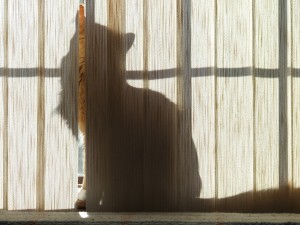Written by Tracy Dion, September 2011
 The two most common fears that raw feeding neophytes have involve bones and bacteria. Today, we’re going to focus on the big bad specter of bacteria.
The two most common fears that raw feeding neophytes have involve bones and bacteria. Today, we’re going to focus on the big bad specter of bacteria.
Bacteria are everywhere. They are a natural part of our ecosystems and can be found from the depths of the oceans to the heights of the mountains. They are in the soil, in the air, and in the bodies of all animals – including ours. Bacteria are an integral part of the health of this planet and as such, are inescapable.
Potentially dangerous bacteria are in our food chain; as evidenced by several recent recalls, in both the produce and meat supplies. Every food we offer our cats has some level of health risk. The question lies not in whether such risks exist, but in the quantification of those risks. Raw meat can be contaminated with bacteria, but kibble can be contaminated with the same pathogens and contains the added dangers of fungus and mold toxins, which have killed and sickened many pets. The Center for Disease Control recommends that pet owners not feed pets in the kitchen or wash their food and water dishes in the kitchen sink or the bathtub, though no such warning has been issued for the daily preparation of the family’s home-cooked chicken or steak dinner.
Commercially-produced cat foods also contain the risks of inadvertent vitamin deficiency or toxicity (or both!), not to mention the quality control issues inherent in the pet food industry’s processing practices. The 2007 pet food poisoning horror is a prime example of such potential contamination.
So what’s a kitty owner to do?
Why, we provide our cat the fuel her high-performance gastrointestinal system is designed to run on. As an obligate carnivore, she is uniquely, specifically and extraordinarily well designed to thrive on the tissues and bones and organs of prey animals, and that is exactly what we should be feeding her. It is the diet that contains the consistently highest-quality nutritional profile and the lowest risk of contaminants.
Ah, but what about those pesky, potentially harmful pathogens?
As difficult as it may be to believe, it is a basic premise of natural science that cats, like all animals, are born with the tools and conditions necessary to maintain their health. In this case, they have evolved a natural and effective defense against the bacteria found in their foods and environment. It starts right in their mouths, with a salivary enzyme called lysozyme. This enzyme attacks bacteria and other pathogens, and can even neutralize bacteria on their fur during grooming.
Bacteria that make it past the mouth hit an extremely acidic stomach that contains hydrochloric acid and several digestive enzymes; an environment highly inimical to those pathogens. Once past the stomach and into the small intestine, bacteria encounter additional obstacles, including strong antimicrobial agents in the form of bile salts from the liver. The pancreas secretes more enzymes as well as bicarbonate, which breaks down the cell walls of invading bacteria.
After the small intestine, digestive matter passes through the large intestine, where high levels of beneficial bacteria flourish. This natural intestinal flora competes with any surviving pathogens for resources, preventing them from taking hold and forcing them out of the body. Lysozyme, the initial gate-keeper, is also present throughout the digestive tract and is expelled right along with the cat’s waste.
All of this happens very quickly, disallowing pathogens time to multiply. Comparatively-speaking, cats have one of the shortest digestive tracts in the animal kingdom. Their body length-to-digestive tract ratio is only 1:4, compared to 1:6 for the dog (and us!), and 1:20 for the cow. Animal-based meals take on average only 12 hours to pass completely through.
Several studies have shown an intimate relationship between the cat’s natural diet and the animal’s intestinal characteristics; what a cat eats affects how that food is digested. The latest edition of The Nutrient requirements of dogs and cats by the National Research Council (U.S.) Ad Hoc Committee on Dog and Cat Nutrition goes into great depth examining the complexities of this relationship. From the amount and composition of saliva secreted during the meal to the activity of stomach and intestinal enzymes and other digestive secretions to the speed at which food is moved through the digestive tract, high protein / high moisture diets have a salubrious effect. Eating a raw diet is not only good for the cat from a nutritional perspective – it causes a chain reaction of chemical events that actively increases the cat’s natural defenses against pathogens.
According to Dr. Celeste Yarnall, the cat’s body is so efficient at managing bacteria that it destroys approximately 98% of the pathogens it ingests. 98%! That’s as effective as America’s most popular cleaning solutions!
From the first lick to their internal chemical reactions to the short transit time, healthy cats truly are well equipped for eating the raw animal diets upon which they are so beautifully designed to thrive.
(See also Raw Feeding and Health-compromised – IBD, FIV+, etc. – Cats.)
If you enjoyed this article or found it informative, please “Like” it, “Tweet” it, or share it using any of the buttons below. And don’t forget to check out our FB page, join the discussions in our awesome FB group and follow us on Twitter!
Created 02/02/12; Updated 11/24/15

